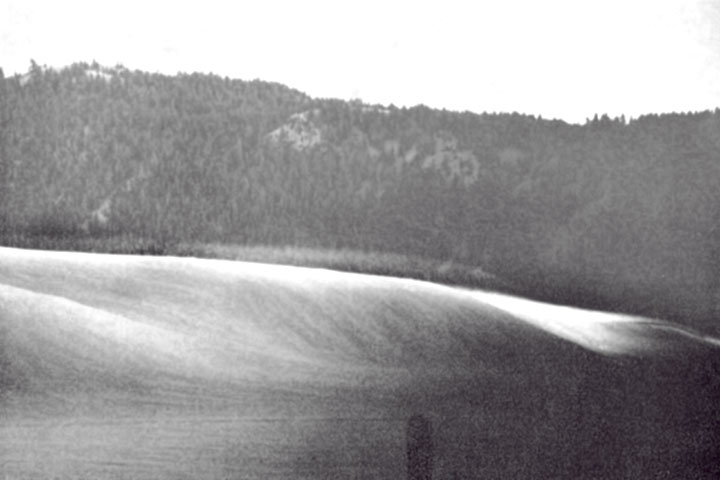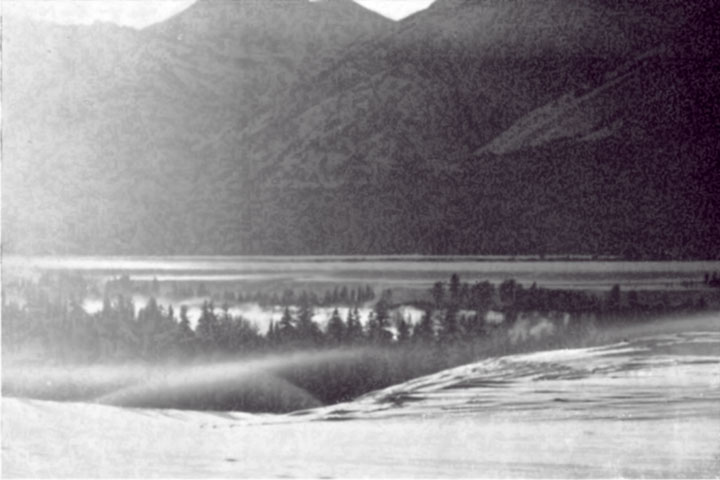Observe, photograph, interpret, publish. For fifty years I have been remarkably consistent with a procedure that I described for a forthcoming article in Wildlife Afield: Photography is my muse as I explore the natural world.
While the roots of this behaviour extend to childhood, this March marks the fiftieth anniversary of my having completed all the steps. It was on the 11th of January 1965 that I watched something interesting in the Grand Teton National Park (Wyoming, USA), took pictures, and speculated on the cause. The resulting article was published as SOME FOG, AN INVERSION, AND A THERMAL in March of 1966 in a magazine of the Royal Meteorological Society (Weather, Vol. 21, Issue 3, pp 76 – 77).
As I reread that article, I find the pictures and the discussion of the flow of air were good, but my discussion of the flog formation was wanting. What can I say? I was a student at the time and, not surprisingly, my skills in making sense of the natural world have developed over the intervening half century. Indeed, time has also improved image quality, and shortened the time for image acquisition and publication.
Now, fifty years later, I present the original images and use some of the original text for their captions.
— begin quoted material —
While driving through the Grand Teton National Park in Wyoming at sunset on 11 January 1965, I was intrigued by the way a thin skin of fog flowed down off the hills in the east, across the highway and on down to the valley floor. The fog, though no more than a foot thick, was gliding about 3 or 4 ft above the snow surface like a huge bed-sheet. It appeared to be a water fog and was moving at about 4 to 6 miles/hr. [This] is a view looking to the south-east. One can see the skin of fog moulding itself to the curves of the snow slopes as it flows roughly from left to right. The narrow ridge visible in the first picture provided an interesting verification that the fog was indeed drainage.

A fascinating aspect of the whole scene occurred after the fog sheet had flowed across the road and was making its way down to the valley floor where hot springs abound. Clouds produced by the hot springs are visible among the trees. One such hot spring apparently lay just over the bank from where the picture was taken. A moist thermal which formed over it was trapped from its inception under the inversion at the top of the drainage fog sheet. The thermal found, however, that it could flow up the side of the bank and remain under the inversion, but upon reaching the top of the bank it had nowhere to go but to try unsuccessfully to break through the inversion. The top of the thermal is outlined in fog due to mixing and cooling at its surface as it passed through the cold-drainage air. The second picture shows its maximum penetration into the inversion. The thermal would then collapse, only to reform and make another unsuccessful assault. The whole process was repeated every 1 or 2 minutes. So captivating was this battle between the thermal and the inversion, which was manifest by the thin fog layers, that I neglected to collect sufficient data to construct a sounding.

— end quoted material —
So, what was going on? I offered correct interpretations of both the shallow katabatic wind flowing towards the valley bottom and of the thermals rising from the hot springs to meet it. However, my treatment of the fog formation was muddled. The fog would have actually resulted from vapour mixing at the interface between the shallow layer of cold air draining down the slope and the overlying air. The same is true of the fog in the shell surrounding the thermals.
While my original interpretation was uneven, it was a good beginning to a lifetime of using pictures as an aid to making sense of the natural world — a practice that persists in this blog.

Congratulations, and thanks for including us in your journey.
How delightful to compare that article to now! For some reason, the phrase “thin skin of fog flowed” is now stuck in my head.
congrats! and thanks for helping us making sense of the world!, although i only got to enjoy the last 15 of them! peter b
Thanks again . I am so happy to be included in your postings. . Irene mcI